Choosing the right wood for your cutting boards is key. It affects how long they last, how sharp your knives stay, and if they’re safe for food. Hardwoods are usually better than softwoods for cutting boards.
Popular hardwoods for cutting boards include maple, walnut, and cherry. They’re strong and easy to find. Exotic woods like padauk, zebrawood, and purpleheart are also used for custom boards.
The best wood for you depends on what you like. Things like how dense the wood is, how porous it is, and if it’s toxic matter. Keeping your cutting board well-maintained is important, no matter the wood.
Key Takeaways
- Hardwoods are generally preferred for cutting boards, but some softwoods can also be used.
- Maple, walnut, and cherry are the top three domestic hardwood choices for cutting boards.
- Exotic wood species like padauk, zebrawood, and purpleheart are popular in custom cutting boards.
- Regular maintenance, such as oiling and conditioning, is crucial for the longevity of your cutting board.
- The best wood for your cutting board depends on your personal preferences and needs.
Why Choosing the Right Wood Matters
The wood you pick for a cutting board greatly affects your kitchen. It keeps knives sharp, ensures food safety, and helps the environment. Choosing the right wood is key.
The Impact on Knife Sharpness
Hardwoods like maple and walnut are best for cutting boards. They keep knives sharp. Maple is very hard, with a Janka rating of 1450, and walnut is 1010.
These woods have a smooth surface. They don’t dull knives quickly.
Health and Safety Considerations
The wood’s porosity is important for food safety. Woods like mahogany, oak, and butternut are not good. They can hold bacteria and mold.
On the other hand, woods like maple and bamboo are better. They don’t soak up liquids and stop harmful germs.
Environmental Sustainability
Choosing sustainable woods like bamboo and FSC-certified hardwoods is good for the planet. Bamboo grows fast and is a green choice.
When picking wood, think about the environment. It helps make a greener kitchen.

In short, the wood you choose affects your knives, food safety, and the planet. Opt for durable, low-porosity, and eco-friendly woods. This way, you get a cutting board that’s good for you and the earth.
Types of Wood Commonly Used for Cutting Boards
The type of wood used in cutting boards is key. Hardwoods are better than softwoods because they last longer and don’t scratch easily. Maple, walnut, cherry, and teak are top picks for their special qualities.
Hardwoods vs. Softwoods
Hardwoods like maple, walnut, and cherry are top choices for cutting boards. They’re tough and don’t dent or warp, making them durable. Softwoods, like pine, are not good because they’re soft and can hold bacteria.
Popular Options Explained
- Maple is a classic for cutting boards because it’s strong and doesn’t mark easily.
- Walnut looks great but might stain things if it gets wet.
- Cherry wood has a nice grain and works well for cutting boards.
- Teak is water-resistant and keeps its surface smooth, making it a top pick.
Not all woods are good for cutting boards. Avoid hemlock, oleander, and boxwood because they’re toxic or not right for cutting boards. Pick a hardwood that’s tough and safe for food.

“For the best cutting board, choose a hardwood that’s dense, scratch-resistant, and safe. The right wood makes a big difference in your kitchen.”
Knowing about different woods helps you pick the best cutting board for your kitchen.
Maple: The Classic Choice
Maple is a top pick for cutting boards. It’s very durable, with a Janka hardness rating of 1450, just a bit higher than white oak. Its closed-grain structure prevents scratches and stops bacteria from growing, keeping your kitchen clean.
Maple also looks great in any kitchen, with its fine grain and golden color. While oak is popular in the South, maple is loved everywhere, especially in the Northeast. Chefs love it for its clean, safe look.
Caring for Maple Cutting Boards
Keeping your maple cutting board in good shape is easy. Just oil it with food-grade mineral oil to keep it moist and protected. With the right care, a maple cutting board can last for many years, making it a smart choice for your kitchen.
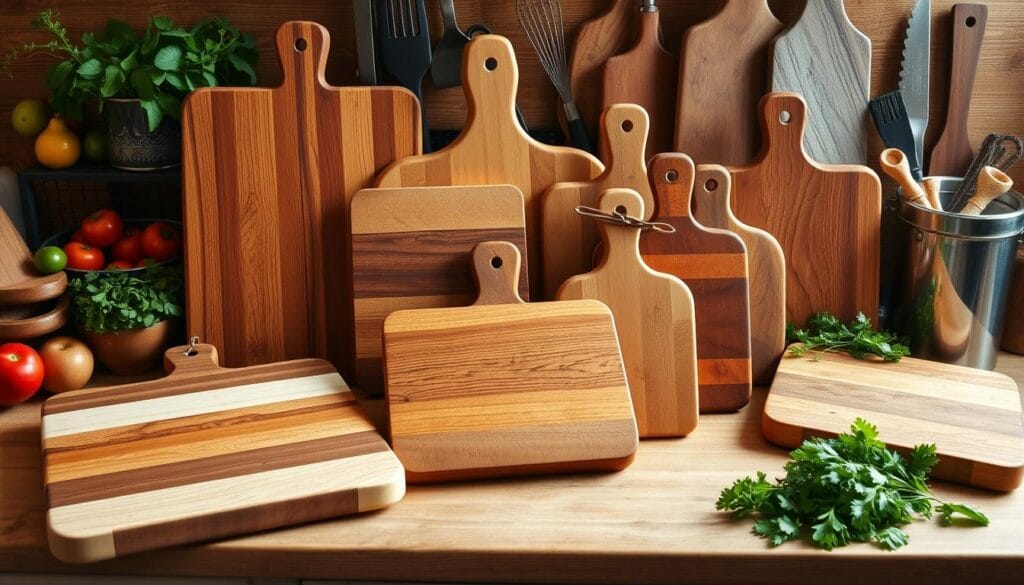
“Maple is a classic choice for cutting boards due to its durability, sanitary properties, and attractive appearance. Its fine grain and golden hue make it a popular option among discerning chefs.”
| Wood Type | Hardness (Janka) | Durability | Color | Cost |
|---|---|---|---|---|
| Hard Maple | 1,450 | Very Durable | Golden | Moderate |
| White Oak | 1,360 | Durable | Dark | Higher |
Walnut: A Stylish Alternative
Walnut is a top pick for cutting boards, blending style with practicality. It has a Janka hardness rating of 1010. This makes it durable yet friendly to knives, appealing to both woodworkers and home chefs.
The deep, dark colors of American walnut add beauty to any kitchen. It’s a favorite for its rich look.
Advantages of Walnut for Cutting Boards
Walnut is great for cutting boards because it resists scratches, dents, and knife marks. Its moderate hardness doesn’t dull knives quickly but keeps them sharp. Plus, its grain structure stops bacteria from building up, making it clean for food prep.
Maintenance Tips for Walnut
Keeping your walnut cutting board in good shape requires regular oiling. Walnut’s natural oils can wear off, causing it to dry and crack. Use a food-grade mineral oil or beeswax conditioner every few weeks to keep it shiny and prevent dryness.
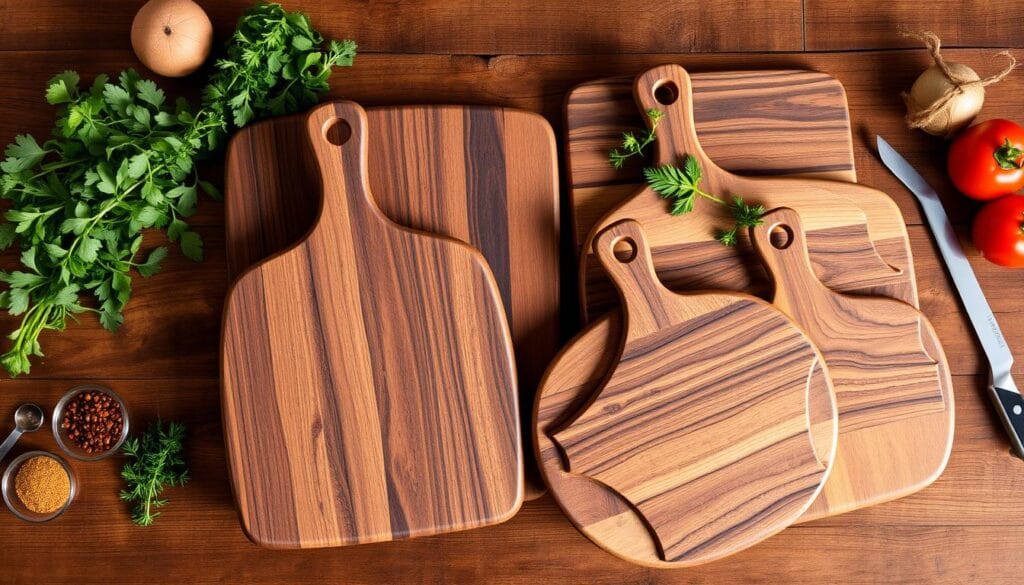
Walnut is ideal for those wanting a high-quality cutting board. It’s durable, stylish, and easy to care for. Whether you’re a pro chef or a home cook, a walnut cutting board will make your kitchen look and work better.
Bamboo: A Sustainable Option
Bamboo is a fast-growing, sustainable material that’s gaining popularity for bamboo cutting boards and eco-friendly kitchen tools. It grows back quickly, unlike traditional hardwood trees. This makes bamboo a great choice for those who care about the environment.
Bamboo cutting boards can last for decades because they are so durable.
Pros and Cons of Bamboo
Bamboo has natural antimicrobial properties, making it better than some materials at fighting bacteria. Studies show wood cutting boards kill bacteria in five minutes, while plastic surfaces can harbor them forever. But, bamboo might be harder on knives than some hardwoods. So, it’s important to take care of your knives.
Cleaning and Care for Bamboo Boards
To keep bamboo cutting boards in good shape, they need regular oiling and should be hand-washed. Unlike hardwoods, which take decades to mature, bamboo grows fast. This makes it a sustainable choice for those who want to help the environment.
People love bamboo cutting boards for being eco-friendly, lasting long, and looking good.
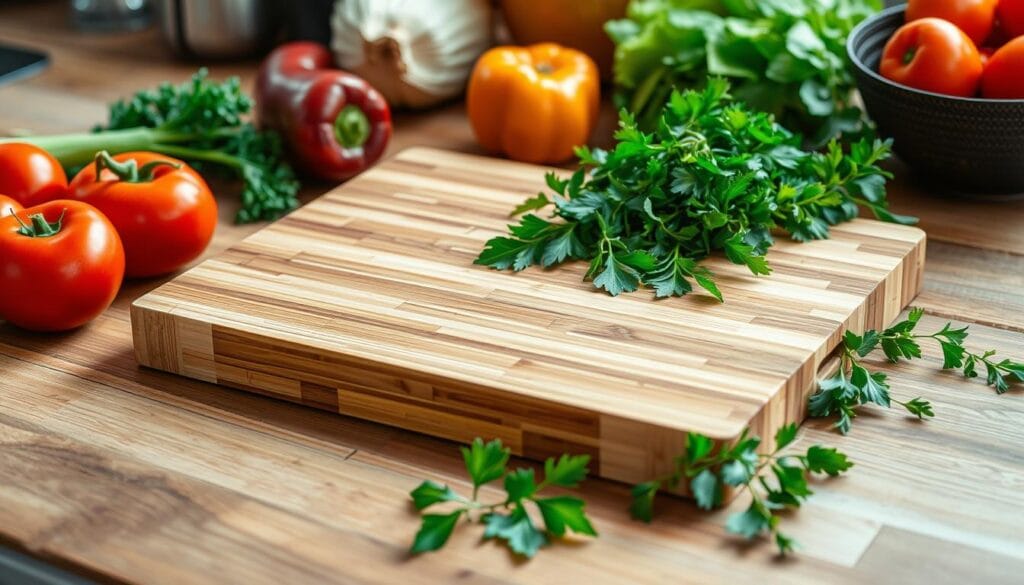
When picking a bamboo cutting board, look for ones that are Forest Stewardship Council (FSC) certified for sustainable sourcing. Remember, regular oiling and hand-washing are key to keeping your bamboo cutting board in top shape.
| Material | Microplastics Released |
|---|---|
| Polyethylene Chopping Boards | 7.4–50.7 g per person annually |
| Polypropylene Chopping Boards | 49.5 g per person annually |
Bamboo cutting boards are a better choice than some plastics because bamboo grows fast. Choosing FSC-certified bamboo helps ensure it’s sourced responsibly and reduces your environmental impact.
“Bamboo is a renewable, durable, and sustainable material that is an excellent choice for eco-conscious consumers looking to minimize their carbon footprint in the kitchen.”
Cherry Wood: Beauty Meets Function
Cherry wood cutting boards are top picks for kitchen surfaces. They look great and work well. Their rich, reddish-brown color gets even more beautiful over time, making any charcuterie spread look amazing.
Features of Cherry Cutting Boards
Cherry wood is tough and can handle sharp knives without damage. It keeps food flavors fresh by not letting them mix with other tastes. Plus, it’s safer than plastic because it doesn’t grow as many bacteria.
These boards come in many sizes and shapes. You can find the perfect one for your charcuterie needs. Cherry wood is also good for the planet if it’s harvested right, making it a green choice for your kitchen.
How to Maintain Cherry Wood
Keeping a cherry wood cutting board clean is easy. Just wash it with warm water and mild soap, then dry it well. You should also oil it sometimes with food-safe oil or wax to keep it looking good.
With the right care, cherry wood cutting boards add beauty and function to your kitchen. They make your charcuterie look great and keep it safe and fresh for a long time.,

Cherry wood charcuterie boards come in different prices to fit your budget. For example, a 18″ x 12″ board is $55.00. Boards with maple and walnut inlays cost between $125.00 and $155.00.
Teak: Durability and Rich Color
Teak is a top pick for cutting boards, known for its lasting quality and beautiful color. Its dense wood is very hard, with a Janka hardness of 1155. This makes it strong against scratches and wear from daily use. Teak also has natural oils and silica, which help it stay water-resistant. It won’t warp, crack, or rot when exposed to moisture.
What Makes Teak Special?
Teak has a tight grain that’s smooth for knives, preventing them from getting dull quickly. This makes it perfect for both home cooks and professional chefs. Its rich golden-brown color also adds elegance to any kitchen.
Caring for Teak Cutting Boards
Teak cutting boards need less oil than other woods but still need care. A quick clean with a damp cloth and some food-safe teak oil now and then will keep them looking good. 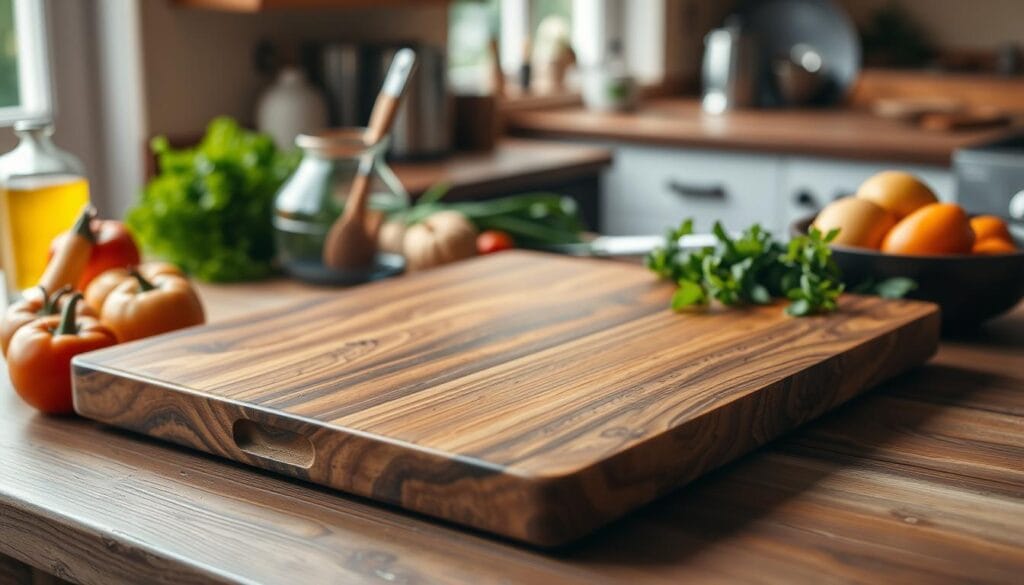
Even though teak cutting boards are pricier, their durability and beauty are worth it. With the right care, a teak cutting board will become a valuable part of your kitchen.
Acacia Wood: A Versatile Choice
Acacia wood cutting boards are durable and look great. They last a long time, even with daily use. The boards have a beautiful grain pattern, from light golden to rich reddish-brown, adding warmth and style to kitchens. Plus, they naturally resist water and stains, perfect for kitchens.
Benefits of Choosing Acacia
Acacia wood is good for the planet because it grows fast. It’s also very hard, with a Janka rating over 1800, making it tough against dents and scratches. This means your acacia cutting board will look and work great for many years.
Tips for Maintaining Acacia Boards
Keeping your acacia wood cutting board in top shape is easy. Just oil it regularly and avoid sudden temperature changes. Acacia boards are also easy to care for because they naturally fight off bacteria and moisture. With the right care, your acacia cutting board will be a valuable asset in your kitchen.
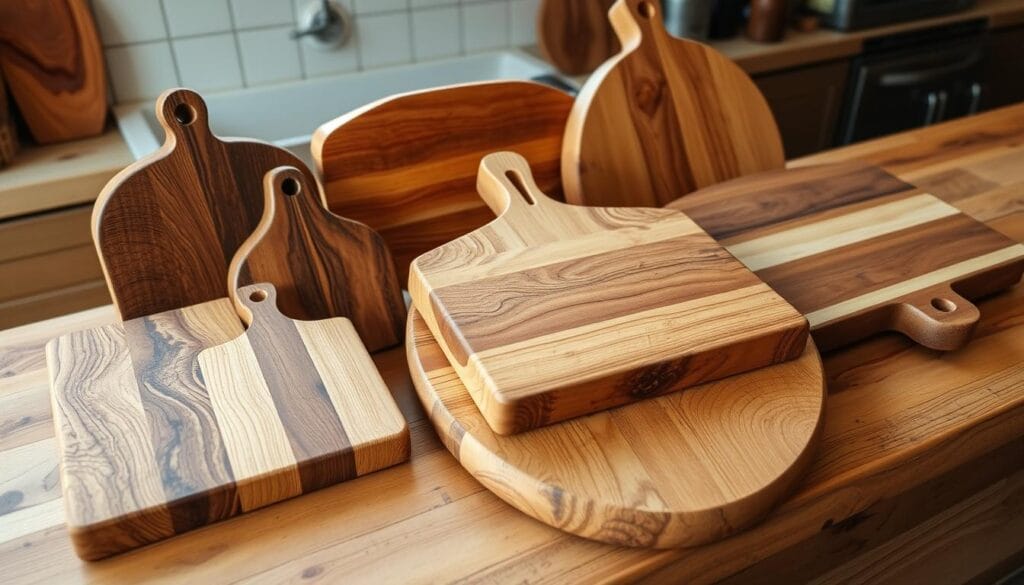
Compared to other woods, acacia cutting boards are both versatile and durable. They have natural antimicrobial properties and don’t warp or crack easily, making them a smart choice for kitchens. Whether you’re a pro chef or a home cook, an acacia wood cutting board will improve your cooking and kitchen style.
Composite and Recycled Wood Boards
Composite and recycled wood boards are great for those who care about the planet. Composite cutting boards are made from recycled paper and resin. They are strong, green, and easy to clean. They also look sleek and dark, which chefs love.
Wood composite cutting boards mix the beauty of wood with extra strength. They are also good at keeping moisture out.
Recycled wood boards are a green choice that still looks like real wood. They last a long time and are easy to use with knives. When choosing, think about how often you cook, what your kitchen looks like, and how green you want to be. Cleaning and conditioning them as needed keeps them in top shape.
What Are Composite Cutting Boards?
Composite cutting boards are made from recycled paper and resin. They are tough, green, and easy to clean. Chefs love them for their durability and cleanliness.
Advantages of Recycled Wood Options
Recycled wood boards are green and still look like real wood. They are strong against cuts and scratches, but still show the beauty of wood. Plus, they don’t hold onto bacteria or smells, making them simple to keep clean.
“Composite and recycled wood cutting boards offer a winning combination of sustainability, durability, and style for the eco-conscious kitchen.”
Final Thoughts on Selecting Wood
Summary of Best Woods
Choosing the right wood for cutting boards can be a bit overwhelming. Maple, walnut, and cherry are often the top picks. They’re known for being tough, safe for food, and looking great.
An expert with 40 years of experience recommends Maples and similar species. They’ve been used for cutting boards for over 1000 years. Other good choices include American hardwoods like ash, hickory, pecan, and sycamore. Exotic woods like purple heart, yellow heart, and zebrawood can also make your cutting boards stand out.
Making the Right Choice for Your Kitchen
Think about hardness, grain type, and how easy they are to care for when picking wood for your cutting boards. Make sure they’re at least 100mm thick. “Stump style” blocks at 300mm are even better for lasting longer.
It’s important to oil and wash your cutting boards by hand regularly. This helps them last longer, no matter the wood. With so many choices, pick the wood that fits your kitchen and cooking style best. Whether you want something durable, beautiful, or both, there’s a wood for you.
In the end, the best wood for your cutting boards is the one that meets your kitchen’s needs. By knowing what different woods offer, you can choose wisely. This will make your kitchen both functional and beautiful.
FAQ
What factors should I consider when choosing the best wood for a cutting board?
When picking the best wood for a cutting board, think about density, porosity, and safety. Hardwoods like maple, walnut, and cherry are good because they last long and don’t scratch easily. It’s also important to consider how well the wood keeps knives sharp, is safe for food, and is good for the environment.
Why are hardwoods superior to softwoods for cutting boards?
Hardwoods are better than softwoods because they’re tough and don’t scratch easily. Maple, walnut, cherry, and teak are popular for cutting boards. Softwoods like pine are not as good because they’re softer and can get damaged easily.
What are the benefits of using maple wood for a cutting board?
Maple is a top pick for cutting boards because it’s very hard. It scores 1450 on the Janka hardness scale, making it very durable. Maple doesn’t dull knives fast and has a grain that stops bacteria. You should oil maple cutting boards with food-grade mineral oil regularly.
How does walnut compare to other woods for cutting boards?
Walnut is a good choice because it’s durable and friendly to knives. It has a dark color that looks great. American walnut is especially liked for its deep brown color. Walnut needs regular oiling to stay shiny and prevent damage.
What are the advantages of using bamboo for a cutting board?
Bamboo is a fast-growing, eco-friendly option for cutting boards. It’s good at stopping bacteria and can handle water. But, bamboo can be tough on knives. Bamboo boards need regular oiling and should be hand-washed to avoid warping.
How does cherry wood perform as a cutting board material?
Cherry wood has a beautiful reddish-brown color that gets even more stunning over time. It’s softer than maple but still works well for cutting boards. Cherry’s grain is closed, which helps stop bacteria. To keep cherry wood cutting boards looking good, oil them regularly and avoid too much water.
What makes teak a good choice for a cutting board?
Teak is very hard, with a Janka hardness of 1155, making it great for water resistance and durability. Its oil content helps it stay water-repellent and avoid warping. Teak needs less oiling than other woods but should still be kept up to keep its color.
What are the benefits of using acacia wood for a cutting board?
Acacia wood is durable and has beautiful grain patterns. It’s naturally resistant to water and has properties that fight bacteria. Acacia boards are light but strong. To keep them in good shape, oil them regularly and avoid sudden temperature changes.
How do composite and recycled wood cutting boards compare to solid wood options?
Composite cutting boards, made from recycled paper and food-safe resin, are durable and eco-friendly. They’re dishwasher-safe and need less care than solid wood. Recycled wood options are sustainable and still look great.

Oxford library teesside university term dates align with traditional academic calendars,
starting October.